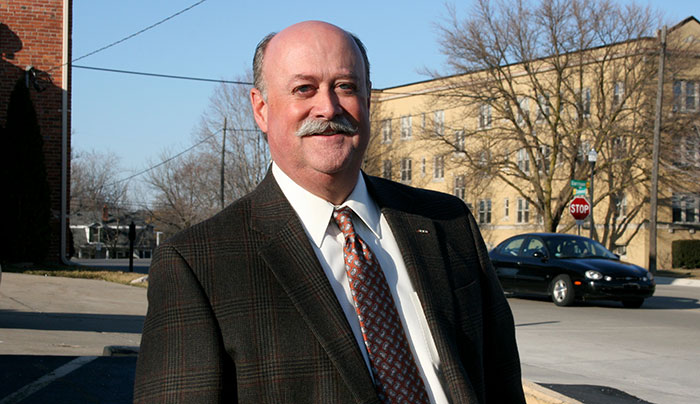In an article published last month by The Rockford Squire, a newspaper in Rockford, Michigan, Notre Dame alum Michael Paletta, MD, (’75) talks about how it’s important to balance technology with personal interaction when it comes to hospice and palliative care.
Balancing High Tech and High Touch in Hospice Care
March 11, 2015 • By The Rockford Squire Paletta volunteered for active duty in Iraq in 2007 where he trained Iraqi doctors in aerospace medicine at an airbase in Baghdad.
Digestible sensors. Fitbits. Telemedicine. Doximity. Electronic aspirin. The pace at which technology is transforming health care is dizzying and attracting big investors. Venture capital firms pump more than $1 billion annually into health care information technology, a number that has more than tripled since 2010.
Yet in an age where health care has gone increasingly high tech, hospice and palliative care providers like Hospice of Michigan may be the last great repositories of "high touch" medicine.
“Ours is a different business,” explains Dr. Michael Paletta, vice president of medical affairs at Hospice of Michigan. “We are not radiology, we are not vascular imaging as hospice providers, we do things that are not amenable to scan, image, program or download.
“So much of our practice is still to sit quietly at the bedside listening to the patients concerns,” Paletta said. “While so many other disciplines are running headlong into technology, hospice providers still have to be very connected to high touch in this high tech/high touch equation. The question remains: How do you blend the two?”
It started with the EMR

"As time goes on, and more and more organizations are using them, we almost take EMRs for granted,” Paletta notes. “While their ubiquity is true in the acute-care hospital world, there are still a lot of hospice programs that aren’t using an EMR. This is an example where we are on the leading edge of an EMR at end-of-life care.”
Hospice of Michigan pairs its EMR with Allscripts, a suite of health-care IT services that allow for scheduling, documentation, billing and other services to create an integrated health-care record for each patient. When a patient or family member calls into HOMs round-the-clock tele-support center, a registered nurse can do instant triage with a patients records and help the family through an after-hours medical crisis either by providing a solution over the phone or dispatching a nurse.
HOM patients and families also benefit from technology at the bedside. For the past seven years, nurses and aides have used tablets and other mobile devices at the bedside to schedule, charge and document their work with patients. “Training,” Paletta cautions, “is critical to success.”
Paletta said patients are not uniformly happy about the use of technology in the practice of medicine. “While we might ooh and ahh over a story that showcases an amazing piece of technology, in the next breath we might complain when our doctor gets out his keyboard during an office visit and starts typing away without taking a minute to examine us or ask how we feel.
“In this case, the technology is not applied well,” he said. “If the provider isn’t trained, the use of technology can be dehumanizing. At Hospice of Michigan, we take the time to ensure all of our team members are properly trained to use technology appropriately in the care process.
Future technology applications
Paletta said HOM continues to evaluate technology to see how advances in the acute-care setting will translate to hospice and palliative care. He said the organization was among the first hospice providers to debut a mobile app that allows family and friends of patients on its program to stay better connected to the care teams of their loved one no matter where they live.
“HOM is now working on the next generation of the app, which will provide more detailed information to families and be a greater benefit,” he said.
Hospice of Michigan recently wrapped up a yearlong pilot program that addresses the current nursing shortage by using an experienced delegating nurse who is able to monitor multiple patients from a remote setting and direct the work of certified nursing assistants or technicians already in the home and working with families.
“Through the work of the Hospice of Michigan Institute, we will continue to develop programs that enhance end-of-life care for our patients,” Paletta explains. “Our goal is to harness the power of technology to free our clinical staff to increase the time they spend interacting with patients and families.”
Comments or questions? mkelly@ndpma.org.
Follow Notre Dame on Twitter at @NDPMA.
About Notre Dame Preparatory School and Marist Academy
Notre Dame Preparatory School and Marist Academy is a private, Catholic, independent, coeducational day school located in Oakland County. The school's upper division enrolls students in grades nine through twelve and has been named one of the nation's best 50 Catholic high schools (Acton Institute) four times since 2005. Notre Dame's middle and lower divisions enroll students in jr. kindergarten through grade eight. All three divisions are International Baccalaureate "World Schools." NDPMA is conducted by the Marist Fathers and Brothers and is accredited by the Independent Schools Association of the Central States and the North Central Association Commission on Accreditation and School Improvement. For more on Notre Dame Preparatory School and Marist Academy, visit the school's home page at www.ndpma.org.

